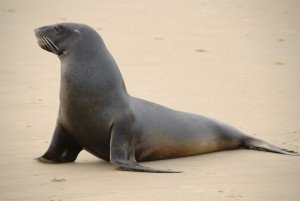The status of the New Zealand Sea Lion has moved from ‘Vulnerable’ to the more serious ‘Endangered’ category in the latest update of the IUCN’s Red List.
 The Red List, maintained by the International Union for Conservation of Nature (IUCN) is considered the definitive international standard for species extinction risk, covering 77,340 species.
The Red List, maintained by the International Union for Conservation of Nature (IUCN) is considered the definitive international standard for species extinction risk, covering 77,340 species.
The latest IUCN update, released today, highlights the changing status of the New Zealand Sea Lion as an example of human-caused population decline:
“The New Zealand Sea Lion (Phocarctos hookeri) – one of the rarest sea lions in the world – has moved from Vulnerable to Endangered, mainly due to disease, habitat modification caused by fishing, and accidental death as a result of bycatch. The species has never recovered from the severe population depletion which occurred due to commercial hunting early in the 19th century.”
The New Zealand Sea Lion primarily inhabits the subantarctic islands south of New Zealand and surrounding waters, though small numbers of them are found at Stewart Island and along the southeast coast of the South Island.
The full profile of the New Zealand Sea Lion can be found on the IUCN Red List website.
The SMC collected the following expert commentary.
Dr Louise Chilvers, Senior Research Officer, Institute of Veterinary, Animal and Biomedical Sciences, Massey University, comments:
“It is sad to see another top predator heading for extinction. Among marine species, the highest proportion of extinctions has occurred in pinnipeds (seals), predominately due to human impacts.
“Commercial fisheries, direct (bycatch deaths) and indirect impacts (habitat destruction for prey species and resource competition), and to a lesser extent, disease outbreaks, are causing the decline in NZ sea lions.
“The New Zealand sea lion is a species where its decline can be reversed. Meaningful fisheries controls and management is urgently needed.”
Disclosure: Dr Chilvers contributed to the IUCN assessment
Dr Bruce Robertson, Senior Lecturer, Department of Zoology, University of Otago, comments:
“I am not surprised that this change has occurred as it reflects the data on and the seriousness of the ongoing decline of the New Zealand sea lion population. When I reviewed all potential causes of the sea lion decline (in the international science journal Mammal Review 2011), the main cause that stood out was fishing impacts – direct (bycatch) and indirect (resources competition). Disease has been suggested as an impact, but current modelling we’re doing at the University of Otago suggests it plays only a minor role.
“An immediate solution is to revert to a precautionary approach to fishing in the squid fishery around the main breeding colonies on the subantarctic Auckland Islands. In 2012, the Minister for Primary Industry increased the level of fishing by 140% on the unverified assumption that fishing impacts (i.e. sea lion bycatch) had been resolved.
“In this year’s squid fishing season, fishermen did the smallest number of trawls ever recorded (616 tows; compared to the allowed number of tows in a season of 4700 tows). Reducing the fishing effort in the squid fishery around the main breeding colonies would be a major step forward in protecting the NZ Sea Lion. Perhaps it is time to weigh up whether the impacts on the NZ Sea Lion is worth such a small amount of squid fishing effort.
“The government is in the process of conducting a Threat Management Plan (TMP) that will run until a final decision is consulted on sometime in 2016. The TMP was announced in the run up to the last NZ election and effectively stifled concerns about sea lion management that were raised by an expert panel review of the sea lion population management in September 2013.
“That review stated that current management is inherently risky and may not be having the desired result. Government ignored the expert panel and instead chose to back its own view that sea lion bycatch is no longer a factor in the population decline, despite lacking the evidence to conclude that mitigation devices are effective. In fact there is reason to believe that these devices (called sea lion exclusion devices or SLEDs) may let dead sea lions out of trawl nets and hence place sea lion bycatch beyond detection.”